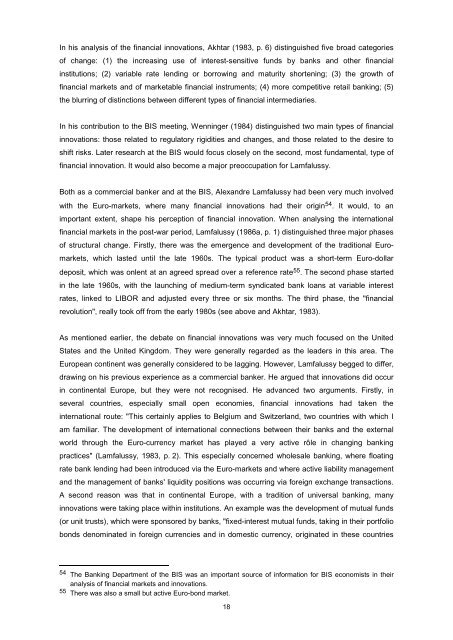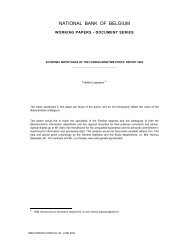Working Paper Research - Nationale Bank van België
Working Paper Research - Nationale Bank van België
Working Paper Research - Nationale Bank van België
Create successful ePaper yourself
Turn your PDF publications into a flip-book with our unique Google optimized e-Paper software.
In his analysis of the financial innovations, Akhtar (1983, p. 6) distinguished five broad categoriesof change: (1) the increasing use of interest-sensitive funds by banks and other financialinstitutions; (2) variable rate lending or borrowing and maturity shortening; (3) the growth offinancial markets and of marketable financial instruments; (4) more competitive retail banking; (5)the blurring of distinctions between different types of financial intermediaries.In his contribution to the BIS meeting, Wenninger (1984) distinguished two main types of financialinnovations: those related to regulatory rigidities and changes, and those related to the desire toshift risks. Later research at the BIS would focus closely on the second, most fundamental, type offinancial innovation. It would also become a major preoccupation for Lamfalussy.Both as a commercial banker and at the BIS, Alexandre Lamfalussy had been very much involvedwith the Euro-markets, where many financial innovations had their origin 54 . It would, to animportant extent, shape his perception of financial innovation. When analysing the internationalfinancial markets in the post-war period, Lamfalussy (1986a, p. 1) distinguished three major phasesof structural change. Firstly, there was the emergence and development of the traditional Euromarkets,which lasted until the late 1960s. The typical product was a short-term Euro-dollardeposit, which was onlent at an agreed spread over a reference rate 55 . The second phase startedin the late 1960s, with the launching of medium-term syndicated bank loans at variable interestrates, linked to LIBOR and adjusted every three or six months. The third phase, the "financialrevolution", really took off from the early 1980s (see above and Akhtar, 1983).As mentioned earlier, the debate on financial innovations was very much focused on the UnitedStates and the United Kingdom. They were generally regarded as the leaders in this area. TheEuropean continent was generally considered to be lagging. However, Lamfalussy begged to differ,drawing on his previous experience as a commercial banker. He argued that innovations did occurin continental Europe, but they were not recognised. He ad<strong>van</strong>ced two arguments. Firstly, inseveral countries, especially small open economies, financial innovations had taken theinternational route: "This certainly applies to Belgium and Switzerland, two countries with which Iam familiar. The development of international connections between their banks and the externalworld through the Euro-currency market has played a very active rôle in changing bankingpractices" (Lamfalussy, 1983, p. 2). This especially concerned wholesale banking, where floatingrate bank lending had been introduced via the Euro-markets and where active liability managementand the management of banks' liquidity positions was occurring via foreign exchange transactions.A second reason was that in continental Europe, with a tradition of universal banking, manyinnovations were taking place within institutions. An example was the development of mutual funds(or unit trusts), which were sponsored by banks, "fixed-interest mutual funds, taking in their portfoliobonds denominated in foreign currencies and in domestic currency, originated in these countries54 The <strong>Bank</strong>ing Department of the BIS was an important source of information for BIS economists in theiranalysis of financial markets and innovations.55 There was also a small but active Euro-bond market.18
















